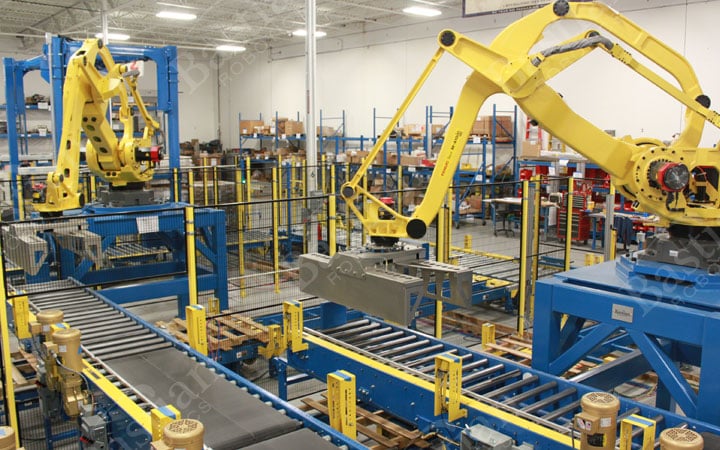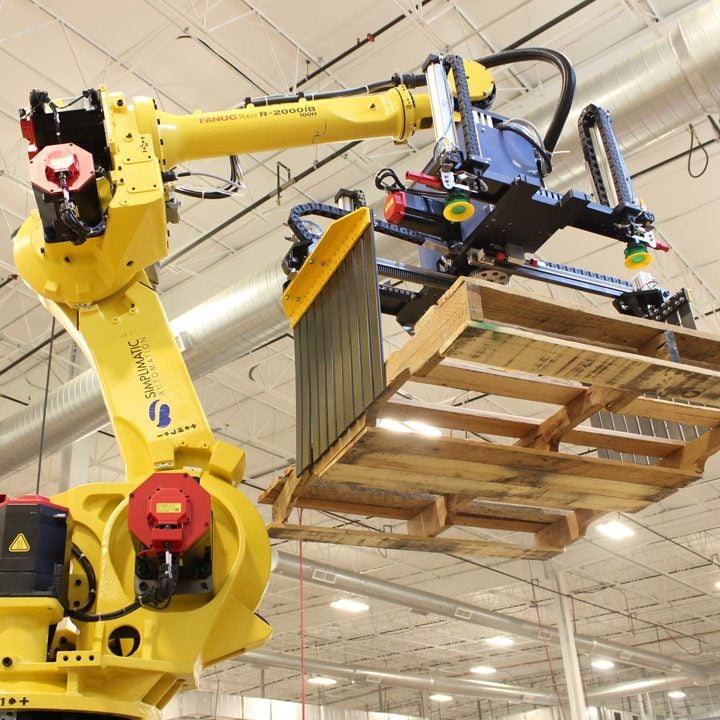This article dives into automated palletizing and the different ways you can automate the palletization process through PLC and robotic controls.
What is Palletizing?
Once a manufactured product is complete and ready for shipment it generally needs to be palletized for convenient distribution. Without automation, workers have to physically handle and stack the product before shipment, requiring a large amount of labor.
Automated palletizing offers significant savings in labor on an assembly line, by stacking the product without the use of human labor.
Some palletizing processes can be done with hard automation and don’t require a robot. Heavy, large bags, such as cement or grain, can be palletized with a series of sliding horizontal doors.
For such simple systems, a PLC or relay control can be enough to run the machinery. These simple palletizers only work if there is a consistent product that does not change size or stack patterns, such as boxes that are always the same size.
For more complicated stack patterns or changing products, a robot is often necessary to handle the changes introduced into the system with product variation. A robot has the ability to change product placement based on information programmed into the system. They can also be used to stack different types of products if they are equipped with a gripper that can handle more than one configuration of a product.
The Importance of Efficient Movements
The programming that controls the palletizing process can make or break a system when it comes to efficiency. A system that optimizes movements between jobs can significantly improve the amount of time it takes to create a full pallet of product.

Palletizers & automated palletizing equipment.
When programming the system it is important to consider when the system will experience intervals in productivity and use that time for other tasks. For example, if the robot has placed all the products from the feed system, it can use that downtime to place a slip sheet on a pallet that needs one.
The most efficient way to do this would be to wait until there is a lag in the product before placing the slip sheet, to keep the system from backing up on the other lanes.
T-cart systems allow for the robot to stack multiple lanes of product simultaneously. When dealing with a system with a T-cart, programming should keep downtime to a minimum and stage pallets in order to avoid delays.
System Reset and Placement Count Override
A major improvement in any palletizing system is to include placement count override, which allows a way to reset the counts on each lane, or for any part of the system.
For instance, if a box falls out of the EOAT (End of Arm Tool) the operator should have the ability to adjust the placement count on the pallet so that boxes do not have to be stacked physically in the empty slot.
An effective tool that makes the reset process user friendly is an HMI touch screen. HMIs can be programmed with buttons to reset each lane to zero, or to add/subtract layers in the stack on the pallet.
This makes an operator’s task much easier and safer than if they had to adjust count manually. Otherwise, the operator would have to create a short stack and finish the stack by hand or go inside the cell to make the configuration of the pallet the same as the current count in the robot after an error in stacking.

A robotic palletizer by Simplimatic Automation.
With an HMI, the system offers more flexibility in the way it can stack. It allows for versatility in the types of products moved simultaneously through one lane. The operator can simply type in updated product dimensions, amount of layers, and slip sheet placements, as needed.
The robot can then offset its pick and place positions to match the box changes, allowing for a much more versatile system. With this arrangement, future products can easily run through the system with little interference.
PLC Controlled vs. Robot Controlled Palletizing
PLC’s run ladder logic to perform tasks in an automated system. Essentially, a PLC runs a sequential code that executes line by line down the “ladder” of the program structure.
PLC Programming Example – Palletizer
This makes them very efficient in the logical processing of sequential tasks. For example, after the robot grabs boxes to palletize them, the PLC can be programmed to begin the next task in the operation, such as signaling for more product to be pushed down the line for staging.
Robot Computing
Robots generally use some form of a C or C++ as their processing language. The use of these languages allows the robots to process information faster than a PLC when computing different processes during production.
The robot has an edge over the PLC during the stacking portion of the palletizing process. It is easier for the robot to compute where the stack layer is, where the next place position will be, and keep track of slip sheet layers all at the same time. Since it can record positions and computations in the background, there is no need for a sequential process, allowing for a more efficient system.
Single Computing System
Although a PLC-Robot combination allows for a very robust and efficient system, one or the other can be used singularly to successfully palletize products.
However, a PLC will require some sort of machinery to move the product, whereas a robot can move the product on its own. Depending on what the product requires, a PLC driven palletizer can offer significant savings in the purchase price of the system by not using a robot, but will be limited in the flexibility of allowable products to some degree.
A robot can run the entire palletizing process, and will require less complicated, hard machinery to accomplish the same job. It does, however, lack in sequential computing, which can be improved with the use of a PLC.
Hence why a Robot-PLC combination set up is recommended to achieve maximum efficiency.
Do you use automated palletizing?
Copyright Statement: The content of this website is intended for personal learning purposes only. If it infringes upon your copyright, please contact us for removal. Email: admin@eleok.com
